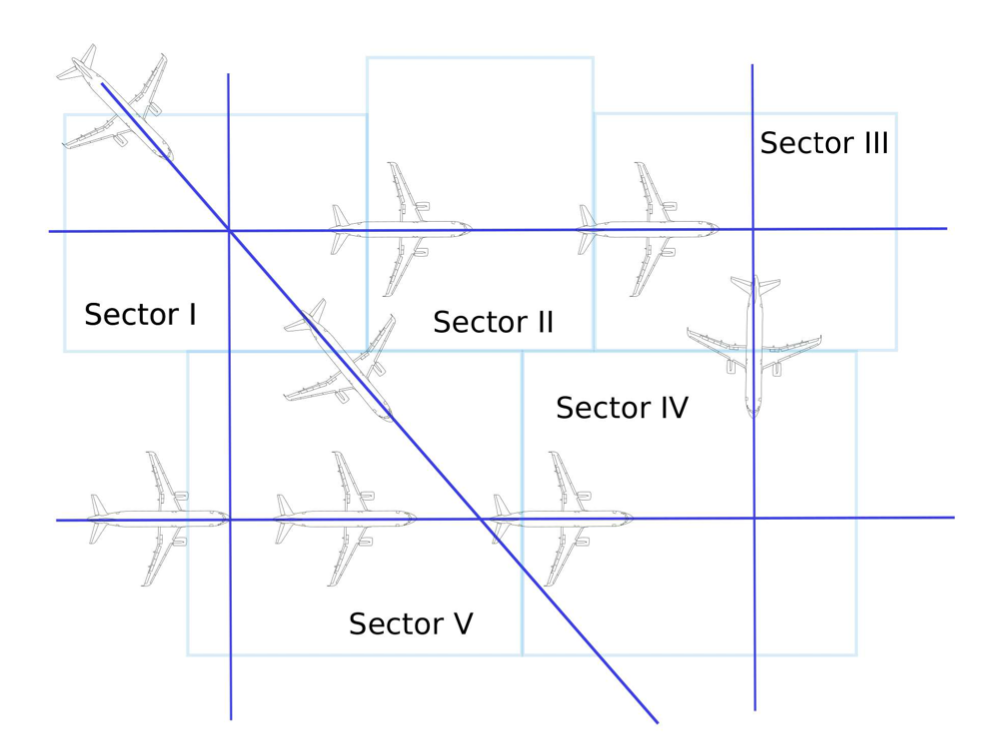10.4: Air Traffic Flow Management (ATFM)
- Page ID
- 77990
The Air Traffic Flow (and Capacity) management can be defined as follows [ICAO Ann. 11]
A service established with the objective of contributing to a safe, orderly and expeditious flow of air traffic by ensuring that ATC capacity is utilized to the maximum extent possible and that the traffic volume is compatible with the capacities declared by the appropriate ATS authority.

Figure 10.12: ATFM sketch.
In other words, the main issue of ATFM is to maintain an equilibrium between capacity and demand. The demand corresponds to the amount of flights expected for a particular time window in a particular region of the airspace (to be more precise, in the ATC sectors). The capacity is driven by the physical characteristics of the element of the system (ATC sectors for en-route or within TMAs) and operational factors (aircraft and human). Figure 10.12 sketches it; for instance if the capacity of Sector V would be 4, there would be and extra aircraft within the sector for a particular time window.13 Actions such as delaying or re-routing some of the aircraft would be required.
In Europe, it is carried out by Eurocontrol’s CFMU (Central Flow Management Unit), which acts as the coordinator at European level, and the FMP (Flow Management Positions), which are unities stablished in the control centers to guarantee the fulfilment of ATFM regulations and to monitor the execution of the operation (reporting to CFMU in case of congestion). The overall objective is to optimise traffic flows according to air traffic control capacity while enabling airlines to operate safe and efficient flights. Eurocontrol starts planning operations as early as possible (sometimes more than one year in advance), consolidating the air traffic forecasts issued by the aviation industry and the capacity plans issued by the Air Traffic Control Centres and airports. It also defines operational scenarios to anticipate specific events which may cause congestion (such as sporting events, Christmas skiing or summer holiday traffic).
This ATFM function can be divided into three temporal phases:
Strategic ATFM, carried out from some months (even one year) to roughly 2 days before the operation. It is based on traffic forecasts (typically coming from repetitive flight plans). Under expected congestion, CFMU might publish a Route Availability Document (RAD). The RAD exposes the set of routes that will not be permitted to the aircraft in order to avoid determined areas to be congested. The company could present the most efficient flight plan taking only into account the limitations in RAD.
Pre-tactical ATFM, carried out from roughly 2 days to roughly 3 hours before the operation. It is also based on traffic forecasts (obviously more up to date), yet considers information from FMPs on the short-term expected capacity. Also, weather forecasts are taken into account to for, instance, reorganise traffic in case of expected convective weather in a particular region of the airspace. The regulations that might apply are published in the so called ATFM Notification Messages (ANMs) & Regulations. They inform about areas where the regulation is going to be applied (airports, sectors, etc.), type of traffic affected by the regulation, flight levels affected, period in which the regulation is expected, procedure of assignation of CTOT. The regulations are issued to the airlines so that they can finally complete their flight plans during the day of operation.
Tactical ATFM, which takes place the day of operation. It is based on the actual flight plans submitted by all companies (typically, flights plans must be submitted to CFMU at least three hours before the operation) and it consists on real-time coordination and balancing of capacity and demand. CMFU uses real time information on the capacity of the sectors based on the information of the FMPs. Under any unexpected situation, CFMU will re-route or delay (the latest is the most typical practise) the flight assigning a Calculated Take-Off Time (CTOT):
\[CTOT = EOBT = TAXI\ TIME + Delay,\]
where EOBT stands for Estimated Off Block Time (stated in the original flight plan). The rule for assignation of CTOT is as follows:
In ordering the flows, it will be only taken into account the estimated time of entry in the regulation area. That is, the priority will be given to the first aircraft estimated to enter the regulated area.
13. notice that the figure illustrate a predicted scenario once CFMU has gathered the information of all flights


